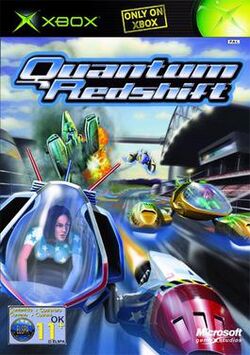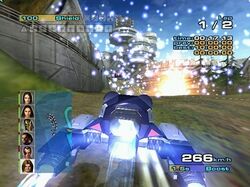Software:Quantum Redshift
| Quantum Redshift | |
|---|---|
 | |
| Developer(s) | Curly Monsters |
| Publisher(s) | Microsoft Game Studios |
| Designer(s) | Nick Burcombe |
| Platform(s) | Xbox |
| Release |
|
| Genre(s) | Futuristic racing |
| Mode(s) | Single-player, multiplayer |
Quantum Redshift is a video game for the Xbox console, developed by Curly Monsters and published by Microsoft Game Studios in 2002. The game is a futuristic racing game with the addition of combat and character rivalries influencing the dynamic of competitive races. Developed by several former staff of the Psygnosis game Wipeout, Quantum Redshift was conceived as a spiritual successor of the game for the Xbox.[1] Publication of the game was troubled, with Curly Monsters staff voicing creative differences on packaging and marketing decisions made by Microsoft Game Studios. The game received mixed to average reviews from critics, with praise directed at the game's visual presentation and smooth framerate, and criticism towards the lack of distinctive and original features in its design and gameplay compared to its contemporaries. The game was commercially unsuccessful, leading to the discontinuation of a planned sequel and the dissolution of Curly Monsters in 2003.
Gameplay
Set one hundred years in the future, Quantum Redshift is a racing game where high-speed races are held on hovercraft known as SPARCs, or single-person armed racing crafts.[2] Races are held across a cast of sixteen selectable characters over eight stages,[3] with each stage featuring two alternate routes. On the track, players have offensive weapons, including a homing and non-homing weapon, and overshields to combat competitors during races. Races also feature power-ups on the track that charge weapons and shields. Players are able to use points to augment their ship between races, with points earned by winning events, collecting objects or defeating opponents.[4]
The game features four modes of play. 'Tournament' mode involves the completion of a series of events. Tournaments are offered in increasing scales of difficulty, with Novice and Amateur modes unlocked initially, and higher difficulty modes increasing the speed of the vehicles during races.[2] Each selectable character in this mode has a rival, with additional points awarded to destroying a rival's vehicle in a race. Upon completion of the tournament, a one-on-one 'Nemesis Challenge' race is staged against the player's rival, allowing them to unlock playing as the rival. 'Time Attack' is a solo timed single race in which laps can be recorded as a 'ghost' for others to compete against. 'Quick Race' is a single race against computer opponents on an unlocked track. 'Multiplayer' mode supports local split-screen races for two to four players.[4]
Development and release
Quantum Redshift was developed by independent studio Curly Monsters, a British company founded in 1998 by six former Psygnosis staff members.[5] Several development staff, including Nick Burcombe, Lee Carus-Wescott and Andy Satterthwaite, had worked on the similar 1995 Psygnosis racing video game Wipeout. Developer Neil Thompson stated the game was conceived to "maximise the Wipeout connection", with a design pitch accepted by Microsoft for the launch of the Xbox with a development budget of one million dollars.[6] Microsoft leveraged several promotional partnerships to boost the profile of the game, including contracting Dutch musician Junkie XL to develop sixteen tracks for the soundtrack of the game.[7] Quantum Redshift was the first video game project Junkie XL, who proceeded to compose tracks for games including Forza Motorsport.[8] Microsoft also engaged Satoshi Ueda, who had worked on the Resident Evil and Street Fighter series, to develop assets for characters and cinematics in the game, including a promotional comic book released for E3 2002 to preview the game.[6]
Promotion and release of Quantum Redshift was troubled, with creative differences between Microsoft and the development team. Although Curly Monsters retained creative control over the game itself, Microsoft exercised control over the release of the game. The working title, Neon, was chased to Quantum Redshift over concerns of copyright infringement with the Chrysler Neon. The development team also expressed strong disapproval towards decisions made by Microsoft on the cinematics and box art of the game, with Neil Thompson stating the team were "desperately unhappy" and "immensely disappointed" with the final art direction.[6]
Sales
Quantum Redshift was not commercially successful, with the game performing poorly in comparison to Wipeout Fusion, released by Psygnosis successor Studio Liverpool the same year.[6] However, poor sales performance had a significant impact on Curly Monsters, with Microsoft Game Studios abandoning its contract with the studio for a second title, leading to discontinuation of a planned sequel. Following this, the company disbanded in February 2003,[6] with Andy Satterthwaite reflecting "while the games were great and reviewed well, they didn’t make enough cash, and we ended up calling it quits in 2003 before we had to put our houses on the line."[9] In the year following release, the game received a minor boost of sales, peaking in the eighth position on Xbox sales charts in the week of 15 November 2003.[10]
Reception
| Reception | ||||||||||||||||||||||||||||||
|---|---|---|---|---|---|---|---|---|---|---|---|---|---|---|---|---|---|---|---|---|---|---|---|---|---|---|---|---|---|---|
| ||||||||||||||||||||||||||||||
Quantum Redshift received a lukewarm reception from critics, with the game receiving "mixed or average reviews" from publications according to review aggregator Metacritic.[11]
Critics praised the visual presentation of Quantum Redshift as a highlight of the game, with a focus on the visual effects and framerate. Writing for Game Revolution, Shawn Sanders praised the visual presentation, stating the game "(shows) the Xbox's prowess to impressive degrees", highlighting the "bump-mapping, snazzy water effects, lush and expansive environments (and) silky smooth framerate."[14] Similarly, Ryan Davis of GameSpot praised the graphics as "outstanding", focusing upon the game's "lighting and particle effects, motion blur and bump-mapping", although noting some effects are "used liberally to the point that the novelty wears off sooner than it should."[15] Hilary Goldstein of IGN described the graphics as "blazingly fast", but noted "of course, that's because there are only six racers on any track and the tracks themselves are static. While the game is pretty, it's not hard to see why when considering what little is truly going on."[17]
Critics were mixed on the track design for the game. Louis Bedigian of GameZone praised the design as "unique", finding them to have "a lot of room to move around" and remarking "the larger scope adds to the depth and realistic feel of the courses."[16] Zach Meston of GameSpy described the tracks as "gorgeous", although found them "sterile...with almost nothing animated other than waterfalls and blinking lights."[3] Ryan Davis of GameSpot praised the inclusion of different surfaces and shortcuts, but found most tracks were not "unique and interesting" and "seem inspired more by conventional rally racing games."[15] Hilary Goldstein of IGN similarly remarked that the track design was "boring" and lacked activity, stating "the tracks don't seem to make much of any sense in terms of the rest of the game...(they) are similar to your average rally game."[17]
Several reviewers remarked that the game was unoriginal and lacked distinctive features. Electronic Gaming Monthly described the game as "generic" and "fun, if uninspired", finding the game failed to add "anything new or revolutionary to the gameplay," citing the lack of weapons and the "bland character designs and uninspired story cut-scenes".[12] Similarly describing the game as "simplistic", Hilary Goldstein of IGN critiqued the "limited" and "plain" use of power-ups in the game, stating "it's not enough to do the minimum."[17] Andrew Bub of XPlay also found the game lacked "inspiration and originality", citing the "generic" story.[2] Shawn Sanders of Game Revolution stated "Quantum Redshift doesn't do much wrong, but it doesn't really try to do much new, either...if you own any other hovercraft racer for any other system, then you more than likely own Quantum Redshift already."[14] Ryan Davis of GameSpot similarly noted the gameplay offered "nothing out of the ordinary."[15]
Retrospective reception
Quantum Redshift received mixed retrospective attention, with critics acknowledging its poor critical and commercial performance. Kristan Reed of Eurogamer positively evaluated the game as a "strangely overlooked" title and "cult classic" for the Xbox, stating it was "the natural successor to Wipeout and the best looking game of its type, with smooth widescreen visuals."[21] In contrast, writing for The Escapist, Jim Rossignol evaluated the game as a "flawed and doomed project", stating "whatever you thought of Quantum Redshift‘s lavish imitations, its water-beaded camera and hyperbolic, spandex-carved pilots, the facts of its critical and commercial slump are undeniable", association its failure to unfavorable comparisons to Wipeout.[22] Richard Moss of Polygon described the game as "lacking the inspiration and coherence of its spiritual predecessor."[23]
References
- ↑ Wright, Gavin (4 September 2002). "Quantum Redshift". https://www.gamingtarget.com/article.php?artid=1965.
- ↑ 2.0 2.1 2.2 2.3 Bub, Andrew (27 September 2002). "Quantum Redshift (Xbox) Review". http://www.techtv.com/extendedplay/reviews/story/0,24330,3400402,00.html.
- ↑ 3.0 3.1 3.2 Meston, Zach (21 October 2002). "Quantum Redshift". http://www.planetxbox.com/features/reviews/2002/quantumredshift/.
- ↑ 4.0 4.1 Quantum Redshift - Game Manual. Microsoft. 2002. https://archive.org/details/xboxmanual_Quantum_Redshift.
- ↑ "Company Profile". 2000. http://www.curlymonsters.com/profile.htm.
- ↑ 6.0 6.1 6.2 6.3 6.4 Win-Poole, Wesley (15 March 2017). "Quantum Redshift: the forgotten Xbox exclusive Microsoft paid $1m for to take on WipEout". https://www.eurogamer.net/quantum-redshift-the-forgotten-xbox-exclusive-microsoft-paid-usd1m-for-to-take-on-wipeout.
- ↑ Bramwell, Tom (16 November 2006). "A little less conversation, a little more Redshift". https://www.eurogamer.net/article-46192.
- ↑ Shea, Cam (16 November 2007). "Junkie XL AU Interview". https://www.ign.com/articles/2007/11/15/junkie-xl-au-interview.
- ↑ Sillifant, Ross (20 August 2014). "GOG Presents The Andy Satterthwaite Interview". http://www.grumpyoldgamers.co.uk/index.php?/topic/2429-andy-satterthwaite-interview/.
- ↑ "XBox Top 20 - 15th November 2003". 18 November 2003. https://www.gamesindustry.biz/xbox-top-20-15th-november-2003.
- ↑ 11.0 11.1 "Quantum Redshift". https://www.metacritic.com/game/quantum-redshift/critic-reviews/?platform=xbox.
- ↑ 12.0 12.1 Gladstone, Darren; Lopez, Miguel; Ford, Greg (December 2002). "Quantum Redshift". Electronic Gaming Monthly.
- ↑ Reed, Kristan (10 October 2002). "Quantum Redshift". https://www.eurogamer.net/r-quantumredshift-x.
- ↑ 14.0 14.1 14.2 Sanders, Shawn (2 October 2002). "Shift Into Neutral". http://www.game-revolution.com/games/xbox/racing/quantum_redshift.htm.
- ↑ 15.0 15.1 15.2 15.3 Davis, Ryan (10 September 2002). "Quantum Redshift Review". https://www.gamespot.com/reviews/quantum-redshift-review/1900-2879845/.
- ↑ 16.0 16.1 Bedigian, Louis (23 September 2002). "Quantum Redshift". http://xbox.gamezone.com/gzreviews/r19994.htm.
- ↑ 17.0 17.1 17.2 17.3 Goldstein, Hilary (16 September 2002). "Quantum Redshift Review". https://www.ign.com/articles/2002/09/16/quantum-redshift-review.
- ↑ Halverson, Dave (October 2002). "Silent Speed". Play (10): 66–67. https://archive.org/details/Play_Issue_010_2002_10_Fusion_Publishing_US/page/2017/mode/2up?q=quantum.
- ↑ Crawley, Mark (October 2002). "Quantum Redshift". Xbox Magazine (12): 76–79. https://archive.org/details/xbm-12.
- ↑ Brookes, Jason (Winter 2002). "Quantum Redshift". Xbox Nation (5): 95. https://archive.org/details/xbox-nation-xbn-issue-5-winter-2002/page/94.
- ↑ Reed, Kristan (22 January 2008). "The Bluffer's Guide to Xbox Cult Classics". https://www.eurogamer.net/a-xboxcultclassics2006.
- ↑ Rossignol, Jim (24 April 2007). "Formula Futurist". https://www.escapistmagazine.com/formula-futurist/.
- ↑ Moss, Richard (9 March 2017). "Wipeout's co-creator looks back at three decades of racing games". https://www.polygon.com/2017/3/9/14846268/wipeouts-co-creator-looks-back-at-three-decades-of-racing-games.
External links
 |


